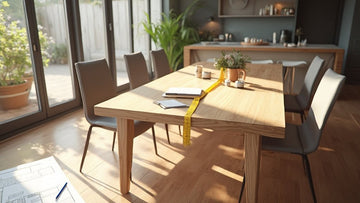You need the right spacing to make your dining area comfortable and easy to move around in. Keep your dining table at least 3 to 4 feet away from walls and other items. When setting up chairs, leave 2 feet of space between them, measuring from the middle of one chair to the next. If you're adding a hanging light, it should sit about 2½ to 3 feet above the table. The size of your room matters too - if you want a rectangular table, you'll need at least a 9-foot by 12-foot space. Getting these key distances right helps create a dining area that looks good and works well.
Key Takeaways
Allow 48 inches of clearance around the dining table for comfortable traffic flow and chair movement.
Position dining chairs 24 inches apart from center to center and 12 inches lower than the tabletop.
Hang light fixtures 30-36 inches above the table surface, with width half to two-thirds of table width.
Plan for a minimum room size of 9x12 feet for rectangular tables seating 4-6 people comfortably.
Maintain 36-38 inches between table edges and walls or furniture for basic accessibility and movement.
Optimal Dining Table Clearances and Traffic Flow
A well-designed dining space needs enough room around the table for people to move and sit easily. Keep at least 36-38 inches between the table's edge and any walls or nearby furniture for basic use.
For the best dining setup, leave 48 inches of open space around the table.
Make sure to plan walking paths through the dining area carefully. Each chair needs at least 24 inches of space to avoid a cramped feeling.
If your dining area is part of a larger room or gets lots of foot traffic, leave 48 inches of space beyond the pushed-out chairs. For guests who use wheelchairs, keep at least 54 inches of clear space around chairs so everyone can dine comfortably.
Chair Spacing and Seating Comfort Guidelines
Good chair placement makes dining rooms more comfortable and welcoming. Keep chairs at least 24 inches apart from center to center so people can eat without bumping elbows.
Chairs should sit 12 inches below the table top, and most dining chairs are 16 to 18 inches tall.
Leave 36-38 inches of space between the table and any walls or other furniture so people can move around easily.
When chairs face each other across the table, keep them 42-48 inches apart to give diners enough room. For guidance on selecting the perfect dining chairs that complement these spacing requirements, explore our comprehensive guide on dining chair styles evolution.
In smaller dining areas, you might need to reduce these spaces somewhat, but try to keep the distances balanced to make the dining area work well and stay comfortable.
Table-to-Ceiling Height Ratios for Perfect Lighting
Good lighting helps create a welcoming dining space. To get the right height, hang your light fixture 30 to 36 inches above the dining table.
If you're using pendant lights, keep them 20 to 24 inches above the table so people can see each other clearly while eating.
For the light fixture to look right, choose one that is half to two-thirds as wide as your table. Make sure to leave at least 7 inches between the bottom of the light and the table's edge so people can move freely. Understanding how lighting choices affect your overall furniture selection can be crucial - learn more about chandelier choice impact.
The height of your room matters too - taller rooms can fit bigger lights while still looking balanced.
Essential Room Dimensions for Different Table Shapes
A well-planned room size helps create a comfortable dining area that works well with any table shape. When measuring for dining tables, you need to think about both the table size and the space needed between the table and walls.
A rectangular table works best in a 9 x 12 foot space for 4-6 people, while a square table needs at least 9 x 9 feet. You should leave 36-48 inches of open space around the table so people can sit down and move around easily.
For a rectangular table with extra furniture, a 14 x 16 foot dining room works best. Most dining rooms in American homes are about 196 square feet, which gives you plenty of options for different table shapes. When considering your table as the centerpiece of your dining space, our guide on statement dining table focal points offers valuable insights.
Round tables need the same amount of space around them as other shapes to make sure people can walk and move chairs freely.
Space-Saving Solutions for Multi-Purpose Dining Areas
Living in today's homes means we need rooms that can do many jobs, and this includes where we eat.
Smart ways to save space help us get the most out of these areas while keeping them nice and comfy.
Tables that can grow bigger, usually from 60 to 72 inches long, work well for both small family meals and bigger dinner parties. For flexible dining solutions, consider exploring extendable dining tables that adapt to your space requirements.
Tables that fold down from walls or have sides that drop down are perfect for tight spaces.
Using benches and built-in seating saves room too, as each person needs just 18 inches of space to sit.
Storage is key, and cabinets about 60 inches wide can hold dishes while also giving you a place to put food when serving.
Chairs that stack easily are also very helpful - you can move them around or put them away when you need the space for other things, and they still look good with your other furniture.
Frequently Asked Questions
What Is a Good Size for a Dining Area?
A good dining area needs about 120 to 196 square feet to work well. This gives you enough room for your table and lets people move around easily. When planning the space, think about how many seats you need, how many people live in your home, and keep paths at least 36 inches wide so everyone can walk through without bumping into things.
What Size Dining Table for a 12X12 Room?
For a 12x12 room, you can fit a rectangular table that's 30 inches wide and 60 inches long, which seats 4-6 people. You could also use a round table that's 48 inches across. Both options leave 36 inches of space around the table, making it easy to walk around and sit comfortably.
Is 32 Inches Too Narrow for a Dining Table?
A 32-inch wide table is a bit too narrow for comfortable dining. While you can eat at it, you'll feel cramped and have trouble fitting plates, dishes, and shared food in the middle. For better dining comfort, look for tables that are 36-42 inches wide, which give everyone enough elbow room and space for a proper meal setup.
What Are the Dimensions of a Dining Place Setting?
Each person needs 24 by 15 inches of space at the dining table for their place setting. This gives enough room to lay out plates, utensils, and glasses while keeping the table neat and making sure everyone has space to eat comfortably.
Conclusion
A well-planned dining space transforms everyday meals into memorable experiences. Our furniture experts at Timbur recommend clearances of 36-48 inches for traffic flow, allowing 24-30 inches per seated guest, and maintaining proper ceiling height ratios for lighting. Whether working with rectangular, round, or square configurations from the Timbur collection, these crucial measurements guarantee both comfort and aesthetic harmony while maximizing available space. For additional insights on creating restaurant-quality dining experiences at home, explore our guide on creating restaurant-like dining experiences.









